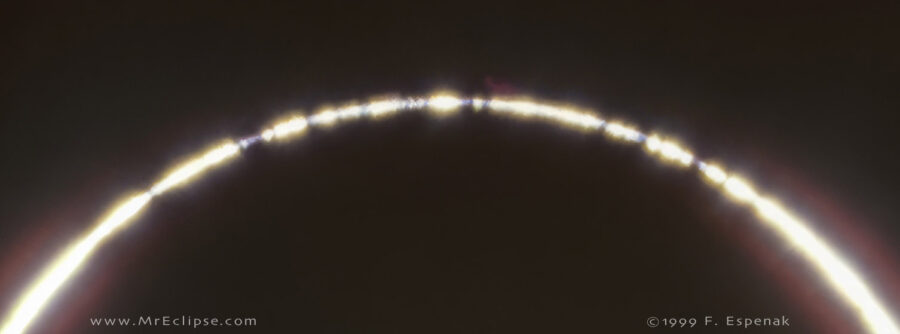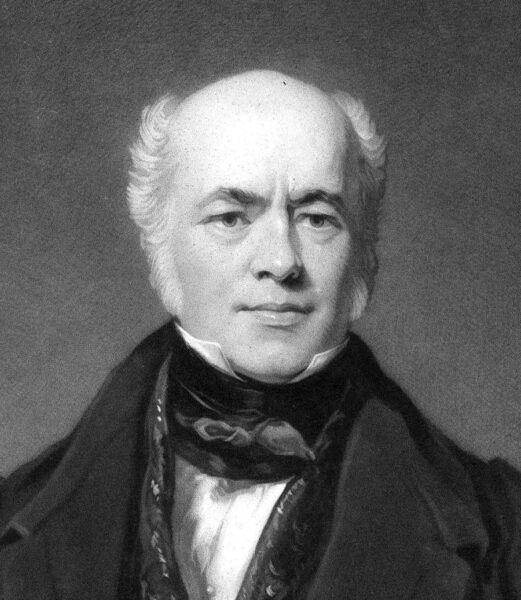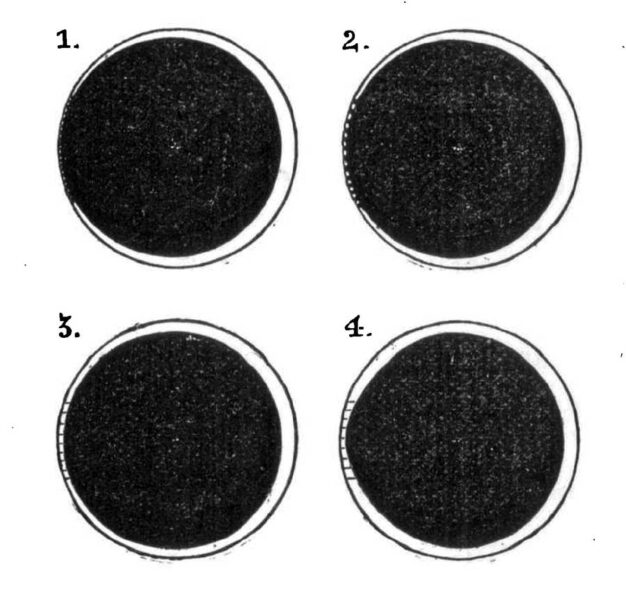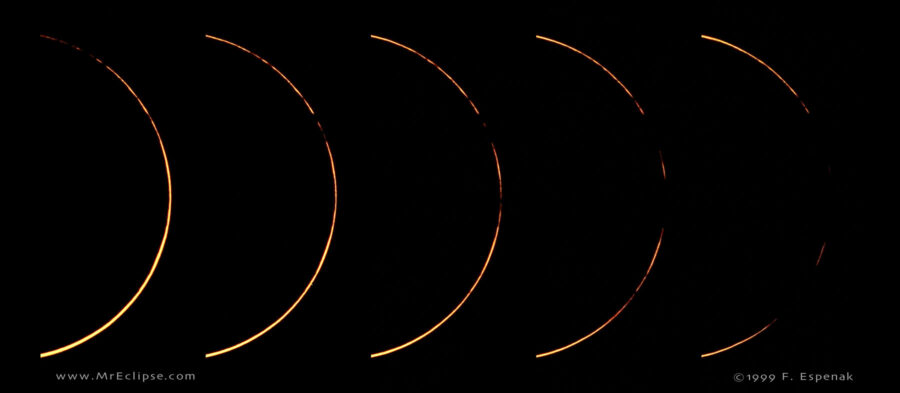
© 1999 by Fred Espenak
Francis Baily was a 19th-century English astronomer and one of the founding members of the Royal Astronomical Society (RAS). Early in his career he enjoyed great success in the financial world as an actuary and amassed enough of a fortune to retire at age 51. During this period, it was not uncommon for gentlemen of wealth to pursue scientific research as a serious pastime, and Baily thus devoted himself fully to astronomy.
Baily was heavily invested in the preparation of star catalogs and was awarded the RAS's Gold Medal for his accomplishments. He was also elected an unprecedented four times as the organization’s president. During his tenure, he became interested in solar eclipses.

In the two centuries that followed the invention of the telescope in 1608, there were few opportunities for European astronomers to observe a total eclipse of the Sun. In fact, while Edmond Halley made a concerted effort to observe the 1715 total eclipse that passed through England, he was primarily interested in the eclipse as a way to refine his calculations of the Moon’s orbit. The use of a total eclipse to study the Sun's features was not yet considered nor even imagined.
No annular or total eclipse had been visible in the British Isles during Baily's lifetime — that is, until the annular eclipse of May 15, 1836. The path of annularity passed through northern England and southern Scotland. Baily could not pass up this rare opportunity. He packed a 2.6-inch f/15 refractor telescope, four pocket chronometers, some other equipment, and traveled north to Inch Bonney in the Southern Uplands of Scotland.
Eclipse day was remarkably bright and sunny without a single cloud. Baily eagerly viewed the partial phases through his telescope. But he was particularly keen to make observations at the start and end of annularity. From previous reports, he expected "meeting with something extraordinary at the formation of the annulus."
Baily made the following detailed description on the formation of the complete ring at the start of annularity.
. . . a row of lucid points, like a string of beads, irregular in size, and distance from each other, suddenly formed round that part of the circumference of the Moon that was about to enter on the Sun's disc. This I intended to note as the correct time of the formation of the annulus, expecting every moment to see the thread of light completed round the Moon; and attributing this serrated appearance of the Moon's limb (as others had done before me) to the lunar mountains; although the remaining portion of the Moon's circumference was perfectly smooth and circular, as seen through the telescope. My surprise, however, was great on finding that these luminous points, as well as the dark intervening spaces, increased in magnitude; some of the contiguous ones appearing to run into each other like drops of water. Finally, as the Moon pursued her course, these dark intervening spaces were stretched out into long, black, thick, parallel lines, joining the limbs of the Sun and Moon: when, all at once, they suddenly gave way, and left the circumferences of the Sun and Moon in those points, as in all the rest, apparently smooth and circular, and the Moon perceptibly advanced on the face of the Sun.

His description of the end of annularity is equally compelling.
When, all at once, a number of long, black, thick, parallel lines, exactly similar in appearance to the former ones mentioned above, suddenly darted forward, and joined the two limbs as before: the same phenomena were repeated, but in inverse order. For, as those dark lines got shorter, the intervening bright parts assumed a more circular shape, and at length terminated in a fine, curved line of bright beads (as at the commencement), till they ultimately vanished, and the annulus consequently became wholly dissolved.
You can read Baily's original paper here.
Baily's description was confirmed by several other observers in the annular path through Scotland. This phenomenon was first alluded to more than a century earlier by Sir Edmond Halley after the total solar eclipse on May 3, 1715.
Halley wrote:
. . . before Total Immersion, the remaining part of the Sun was reduced to a very fine Horn, whose Extremeties seemed to lose their Acuteness, and to become round like Stars ... which Appearance could proceed from no other Cause but the Inequalities of the Moon's Surface, there being some elevated parts thereof near the Moon's Southern Pole, by whose Interposition part of that exceedingly fine Filament of Light was intercepted.
Both Baily and Halley rightly identified the cause of the beads to be the topography along the Moon's limb — the mountains and valleys that either block or reveal the solar photosphere beyond. But because of Baily's more complete description of the phenomenon, it has been called "Baily's beads" ever since.

© 1999 by Fred Espenak
There are two excellent opportunities to witness Baily's beads in the next six months: the annular solar eclipse of October 14, 2023 and the total solar eclipse of April 8, 2024.
You’ll need a telescope with a solar filter to watch Baily's beads at either of these events. A magnification of 30x or more is recommended to resolve the beads in the seconds leading up to and immediately following the annular phase.
For more on the October 14 eclipse, see “The Great Annular Eclipse of 2023” in the October issue of Sky & Telescope and the blog post “Observing the October Annular Eclipse.”
For more on the April 8th eclipse, see “Get Ready for Totality in ‘24” in the April issue of Sky & Telescope.
Retired NASA astronomer Fred Espenak has traveled to 30 total and 11 annular eclipses of the Sun. He has written many books on eclipses including the 2023 annular and 2024 total solar eclipses. For more information, see his website, EclipseWise.com.
Retired NASA astronomer Fred Espenak has traveled to 30 total and 11 annular eclipses of the Sun. He has written many books on eclipses including the 2023 annular and 2024 total solar eclipses. For more information, see his website, EclipseWise.com.
Find more information and resources for the 2024 solar eclipse.
 4
4








Comments
467ParkAinslie
October 7, 2023 at 8:05 pm
Thanks for the great article! Out of curiosity, would astronomers of that time have been using some sort of solar filtering? Or what we would today call eyepiece projection? I don't believe they had the sort of vacuum deposition process used to make modern over-the-aperture solar filters at that time. If Wikipedia is to be believed, even the Herschel wedge was only proposed in the 1830's.
You must be logged in to post a comment.
Fred EspenakPost Author
October 10, 2023 at 11:23 am
Unfortunately, Baily's 1836 paper does not discuss how he attenuated the solar image. I suspect it may have been something similar to a Hershel wedge.
You must be logged in to post a comment.
Russell Sampson
October 12, 2023 at 4:25 pm
Thanks Fred, great article. One of the things that stood out for me was Figure 3 and 4 of Baily's paper. This appears to be similar to the "black drop" effect made famous by transits of Venus. The "parallel lines" and the oblateness of the lunar silhouette in Figure 4 (the moon seeming to stretch to touch the solar limb) all suggest a similar perceptual and/or instrumental distortion that observers have noted with transits of Venus and Mercury.
You must be logged in to post a comment.
Ali-Ebrahimi Seraji
October 15, 2023 at 2:10 am
Hi Fred
During the 2019 Annular Solar Eclipse, I was able to capture a few frames of Baily's beads and compare them to the Kaguya and LRO charts. The comparison of data and results is amazing.
https://spaceweathergallery2.com/indiv_upload.php?upload_id=200708
You must be logged in to post a comment.
You must be logged in to post a comment.